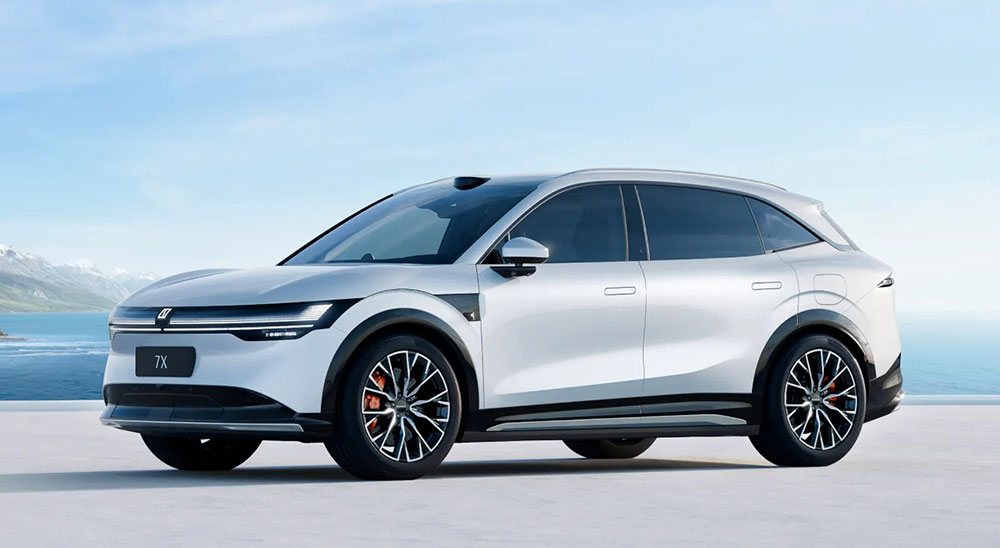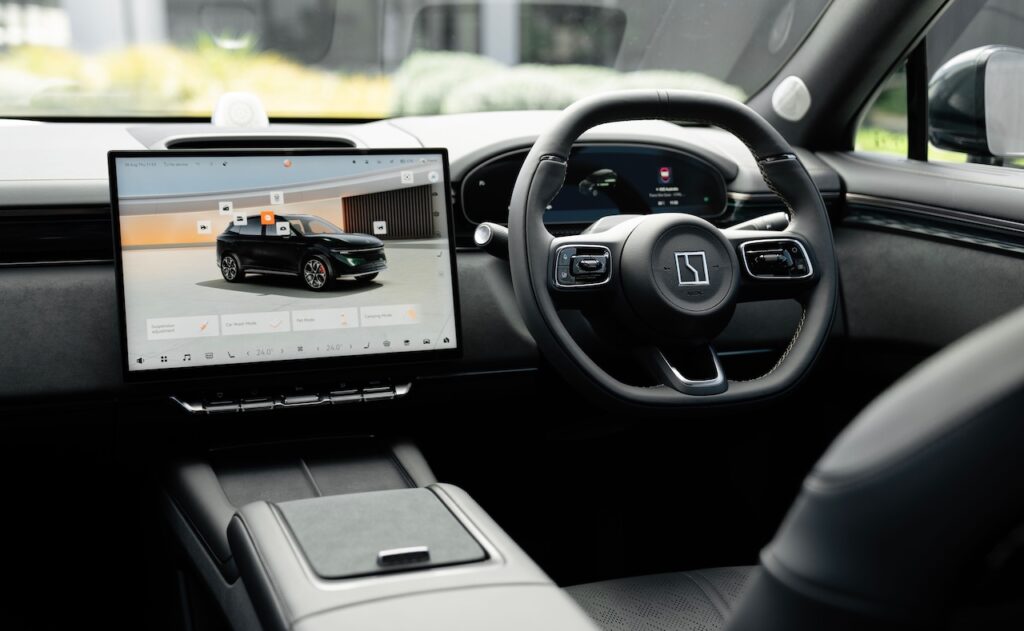
Zeekr’s 7X lands in Australia at an interesting moment for the local EV market. The mid‑sized electric SUV category remains dominated by Tesla’s Model Y, but the 7X – part of Geely’s growing stable of EV brands – is the most convincing Chinese contender to arrive here in volume to date. It blends serious performance claims with competitive pricing, high levels of standard equipment and a package that reads as deliberately aimed at buyers who want something a little more premium than the usual value EV propositions.
What we drove and where
I joined a Zeekr launch in South Australia in 2025 that marshalled unregistered pre‑production cars across a mix of surfaces: gravel rally stages, a converted off‑road quarry and The Bend race circuit. The program was designed to show the car’s versatility and, for the most part, it did: the Performance AWD demonstrated impressive composure on rougher surfaces and under heavy acceleration, while the RWD variants were more clearly tuned toward everyday comfort than track work.
Pricing, range and variants
At launch Zeekr positioned the 7X aggressively on price. The entry single‑motor Rear‑Wheel Drive model was advertised from $57,900 (plus on‑road costs), deliberately undercutting the most obvious rival, Tesla’s Model Y. The mid‑band Long‑Range RWD (100kWh) sits around $63,900 and promises the most useful real‑world balance of range and efficiency. The headline Performance All‑Wheel Drive, which brings the most extreme performance figures – 475kW, 710Nm and a 0-100km/h time of around 3.8 seconds – was listed at $72,900.
Key battery and range notes
- Battery: 100kWh (NMC chemistry) for Long‑Range and Performance; smaller 75kWh pack for the base model.
- Claimed range: WLTP figures vary by variant – Zeekr cites around 615km for the Long‑Range RWD (using WLTP methodology), about 543km for the Performance, and approximately 480km for the base 75kWh car. Expect real‑world numbers to be lower, particularly when using spirited driving or AWD.
- Warranty: standard five‑year unlimited‑kilometre vehicle warranty, with an eight‑year/160,000km battery warranty. At launch Zeekr offered attractive incentives to early buyers, including extended warranty packages for the first tranche of customers.
Charging: 800V architecture – useful now or future‑proofing?
A headline feature is the 800‑volt electrical architecture and Zeekr’s claimed 420-450kW DC charging capability. On paper this enables extremely fast top‑up times: Zeekr claims 10-80% in around 13 minutes on a sufficiently powerful charger for RWD, and slightly longer for Long‑Range and Performance AWD variants. In practice in Australia today, rapid DC infrastructure is improving but remains inconsistent. Networks such as Chargefox and other providers have rolled out a number of ultra‑rapid sites with 350kW and some 400kW+ capacity, but 450kW chargers are still rare. That makes the 7X’s high charging potential more of a “future proofing” advantage than an immediate, country‑wide benefit – though owners who can access the fastest public chargers or high‑power workplace chargers will see better charging performance.
Equipment, interior and practicality
Zeekr has clearly aimed for a premium feel. The 7X avoids feeling like a generic knock‑off of other Geely‑related marques; its lines and cabin details are distinctive and in some angles evoke a Porsche Macan silhouette. Materials and finish are competitive with European rivals: heavier doors, generous soft‑touch surfaces and an interior layout that differentiates it from Polestar and Volvo cousins.
Standard and notable inclusions:
- 16‑inch infotainment screen with Apple CarPlay and Android Auto.
- Up to 21‑inch wheels on the Performance model.
- Panoramic glass roof with power sunshade.
- 3kW vehicle‑to‑load (V2L) capability.
- 539 litres of boot space (expandable to 1,978 litres with rear seats folded).
- Safety: AEB, blind‑spot monitoring, front and rear cross‑traffic alert, surround‑view camera and seven airbags.
- Comfort: 14‑way power driver’s seat, heated front and rear seats and heated steering wheel; the Performance trims add Nappa leather and air suspension with adaptive dampers and five ride height levels.

Driving impressions: RWD vs Performance AWD
The two ends of the 7X line-up feel like different cars. The base RWD, with conventional double‑wishbone front and multi‑link rear suspension, is tuned for comfort and economy; it’s the sensible choice for most buyers seeking a family SUV. On a race track that setup doesn’t shine and body roll was noticeable when pushed hard, but that’s hardly a deal‑breaker for daily use.
The Performance AWD – with air suspension and continuously controlled dampers – is a different proposition. It absorbs rough surfaces competently, controlled body motions well and handled spirited driving with poise. The straight‑line acceleration is addictive, and the AWD system delivers the power in a way that feels purposeful rather than merely theatrical. Brakes on the launch cars were heavily worked and demonstrated fade under repeated track sessions, a reminder that buyers who intend to push an SUV on circuits should consider appropriate brakes and tyres.
Foibles and ergonomics
Zeekr’s cabin mixes convenience with some modern irritants. Many secondary controls are embedded in the touchscreen – including electric steering column adjustment – which some buyers will find slow or distracting. The car also includes novelty external sound effects and other playful software features; you can mute or ignore these, but they underline a different approach to software‑driven customer engagement compared with more conservative European brands.
Where the 7X sits in the market
The 7X represents a compelling offering for buyers who want a high‑spec mid‑sized EV without the Tesla badge. It undercuts or matches key rivals on price while offering a strong equipment list and a performance flagship that challenges the norms of this segment. Its strengths are compelling value, high‑end tech credentials and a genuinely premium interior finish for its price point. Weaknesses to monitor are dealer and service coverage as Zeekr scales up in Australia, real‑world range when driven enthusiastically, and the current mismatch between claimed peak charging capability and the national charging network’s practical availability.
Conclusion
The Zeekr 7X is an important launch for the Australian market because it signals how fast Chinese EV brands are closing the gap on incumbents in design, technology and perceived quality. The Performance AWD model, in particular, is impressive: it blends genuine supercar‑like acceleration with the practicality of a five‑seat SUV, and at a price that will make many buyers think twice about a Model Y.
For most buyers, the Long‑Range RWD is likely to be the sweet spot – offering the best compromise of range, efficiency and cost. The 7X is not without compromises: ergonomics that rely heavily on touchscreen controls and the limited availability of ultra‑high‑power chargers in Australia are real considerations. But as a package, it stands among the best value, most fully specified entrants into Australia’s mainstream EV market in 2025.
FAQs
How does the Zeekr 7X compare to the Tesla Model Y?
The Zeekr 7X competes on price, equipment and interior quality. It undercuts the Model Y at entry level while offering a more premium finish and higher‑spec Performance variant. Tesla still holds advantages in nationwide charging access (Supercharger network) and software maturity, but Zeekr challenges Tesla on value and specification.
What real‑world range should I expect?
WLTP figures are generous; real‑world range will depend on driving style, climate and load. Expect lower numbers than WLTP estimates, especially for the Performance AWD if you exploit its power. The Long‑Range RWD should deliver the best everyday range economy.
How fast can the 7X charge in Australia?
Zeekr claims 420-450kW peak DC charging thanks to 800V architecture. In Australia, most public ultra‑rapid chargers are in the 150-350kW range, with some 400kW+ sites. That means owners will see fast charging at many locations, but true 450kW peak speeds will be limited to very few sites for now.
What warranty and aftersales support does Zeekr provide?
Standard coverage at launch included a five‑year, unlimited‑kilometre vehicle warranty and an eight‑year/160,000km battery warranty. Zeekr also promoted enhanced packages for early buyers; service network coverage is expanding as the brand grows in Australia, but prospective buyers should check local dealer and service availability.
Is Zeekr reliable and are parts and service readily available?
Zeekr benefits from Geely group engineering and component sharing, which supports serviceability. Reliability will become clearer as more cars accumulate real‑world kilometres in Australia. Buyers should consider dealer proximity and the availability of authorised service centres in their area before purchase.
About EV Evolution
EV Evolution is the leading online platform dedicated to Australian electric vehicle owners and enthusiasts. We foster a vibrant community, delivering essential EV news and insights, and enhancing user engagement through our innovative, AI-powered chatbot for dynamic discussions. Our mission is to empower Australian electric vehicle owners and enthusiasts by fostering a vibrant, AI-driven online community that connects, informs, and advances the nation’s electric vehicle landscape.




